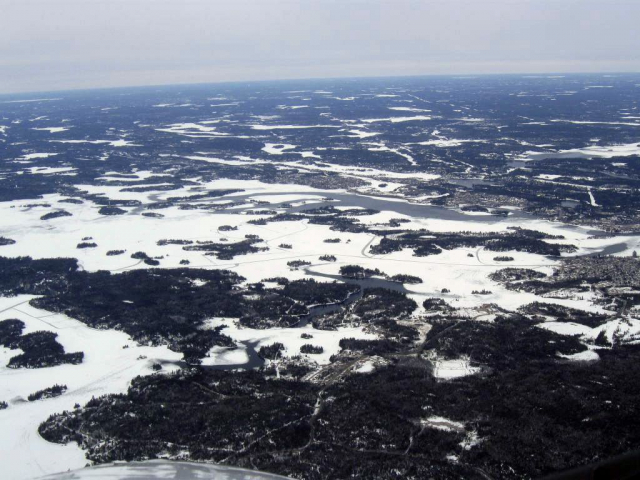 Ice cover April 2013: DevilÕs Gap and Safety Bay on Lake of the Woods. Tim Armstrong/Lake of the Woods Ice PatrolGiven the cold temperatures lately and the quick freeze-up on the lakes around us, I thought it would be interesting to look below the ice surface and find out what really happens under there all winter. For those of us who ice-fish, we know full well that the lake is still full of life, but let’s take a closer look.
Ice cover April 2013: DevilÕs Gap and Safety Bay on Lake of the Woods. Tim Armstrong/Lake of the Woods Ice PatrolGiven the cold temperatures lately and the quick freeze-up on the lakes around us, I thought it would be interesting to look below the ice surface and find out what really happens under there all winter. For those of us who ice-fish, we know full well that the lake is still full of life, but let’s take a closer look.
During the summer, lake surface waters warm up and this layer of warm, less dense water floats on top of the deeper cold waters that are more dense. This is known as lake stratification.
As fall progresses, lake surface waters cool, become more dense and sink and with help from the wind, the lake waters mix from top to bottom. This is what is called fall “turnover” and it plays a critical role in determining what life can survive over winter. As winter begins to set in, the entire lake cools to 4°C. Water reaches its maximum density at this temperature. When air temperatures drop more, the surface waters cool even further and at 0°C start to freeze. At these temperatures, water expands and become less dense, so it stays afloat as it turns into ice.
Lake turnover is critical in freshwater lakes, because it is this transformation that replenishes dissolved oxygen levels in the deepest lake waters. Once the ice forms, there is no oxygen exchange between the water and the atmosphere and the light needed for aquatic plants to produce oxygen is reduced. When the lake surface freezes over, the oxygen in the lake is what it is… whatever oxygen exists at that point in time has to last all winter long for the critters that need it. For this reason, many plants, animals and other forms of life hibernate or go dormant in winter, but a surprising number remain active in colder months. In fact, some organisms only spring to life once a lake freezes over and many others survive only by clinging to the ice’s underside. I was recently reading an article about a team of researchers who looked at 100 freshwater lakes around the world to investigate what life exists under the ice. While we think of algae as a summer phenomenon, these researchers found algae clinging to the underside of the ice in many of the lakes because this is where light is most available at this time of year. Until the ice melts in the spring, these algae and zooplankton are an important food source for newly hatched fish.
What about those fish swimming around in frigid waters? Fish can survive the freezing-over of lakes because they are cold blooded, meaning their body temperature matches their environment. Colder temperatures mean a reduction in their metabolism and a slowing down of respiration, digestion and activity level; since their food supply is reduced, this is a great example of an adaptation mechanism. Cold-blooded reptiles and amphibians that overwinter under the ice survive by hibernating in the mud at the bottom of ponds or shallow bays of lakes.
It is truly amazing that, in the cold and the extreme darkness of a frozen-over lake, life can continue below the surface where nature adapts and provides enough resources to get through to the next spring.
This series is provided as part of the International Watershed Coordination Program of the Lake of the Woods Water Sustainability Foundation (www.lowwsf.com)
